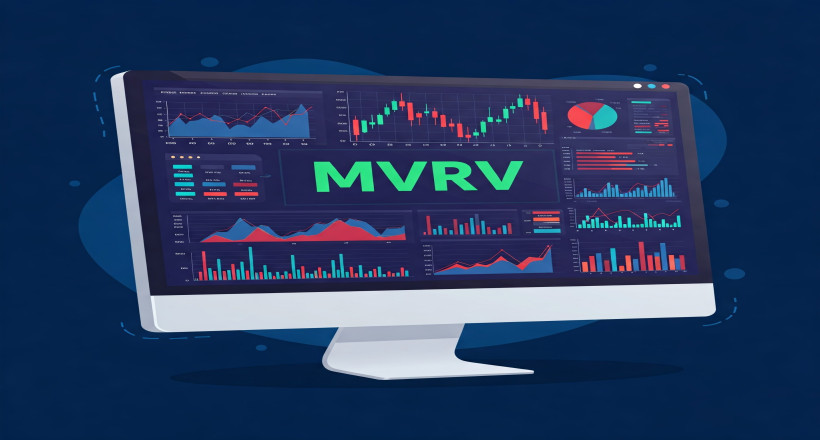
One of the major challenges for cryptocurrency market participants is determining the best time to buy and sell digital assets. The MVRV indicator serves as a powerful tool that helps investors identify price floors and ceilings of cryptocurrencies and determine optimal trading points. By comparing market value with realized value, this metric provides a clearer insight into an asset’s valuation, allowing traders to make more informed decisions. But what exactly is the MVRV indicator, and how does it work? In this article, we will explore this key metric in detail. Stay with us!
What is the MVRV Indicator?
The MVRV indicator stands for Market Value to Realized Value and is recognized as one of the most essential tools in cryptocurrency market analysis. This indicator compares market value (Market Cap) with realized value (Realized Cap) to assess whether a digital asset is overvalued or undervalued relative to its current price. Many analysts and traders rely on this metric to gauge investor sentiment and the overall market condition.
A common application of the MVRV indicator is identifying overbought and oversold conditions. When the MVRV ratio is above 1, it indicates that the market value has surpassed the realized value, suggesting that the asset might be in an overbought (Overvalued) state. Conversely, if the MVRV ratio falls below 1, it means the realized value exceeds the market value, which could signal an oversold (Undervalued) condition. Many investors see this as a potential buying opportunity.
Analyzing the MVRV indicator alongside other analytical tools can provide a more comprehensive understanding of cryptocurrency price trends and market cycles.
Understanding Market Value and Realized Value
To fully grasp the MVRV indicator, one must first understand market value and realized value. Having sufficient knowledge of these two metrics will help in making more precise analyses. Below, we explore these key concepts in greater detail.
Market Value (Market Cap)
Market value, commonly referred to as market cap, represents the total monetary value of a cryptocurrency in circulation. It is calculated by multiplying the current price of an asset by its circulating supply, giving an estimate of the total investment in a particular cryptocurrency. However, relying solely on market value can be misleading, as it only reflects the asset's nominal worth without considering deeper market dynamics. While this metric can help investors identify high-value projects, investing in cryptocurrencies with lower market caps typically carries higher risks. Therefore, combining this metric with other analytical indicators is essential for a more accurate assessment.
Realized Value (Realized Cap)
Realized value, sometimes referred to as intrinsic value, is influenced by various factors such as market demand, financial support, and network activity. Unlike market cap, which multiplies the total supply by the current price, realized value considers the price of each coin at the time of its last movement on the blockchain. This approach provides a more accurate representation of investor behavior, reducing the impact of short-term market volatility and inactive coins. Analysts often use this metric to evaluate market cycles and investor sentiment more effectively.
Applications of the MVRV Indicator
The MVRV indicator is one of the key tools in cryptocurrency market analysis, helping investors and traders make more informed decisions. This indicator has multiple applications, and some of the most important ones are highlighted below:
1. Identifying Cryptocurrency Price Ceilings and Floors
One of the primary applications of the MVRV indicator is detecting the peaks and bottoms of digital asset prices. If this indicator rises significantly above 1, it suggests that the market is approaching its peak, increasing the likelihood of a price correction. Conversely, if the MVRV value drops significantly below 1, the chances of an end to the downtrend increase. Many analysts consider this scenario as a favorable investment opportunity.
2. Analyzing Bullish and Bearish Market Cycles
The MVRV indicator allows traders to better identify different market cycles. As mentioned earlier, analyzing this ratio can indicate whether the market is nearing the end of an uptrend or downtrend. This insight is crucial for making better decisions regarding buying or selling digital assets.
3. Risk Management in Crypto Trading
Investors can use the MVRV ratio to manage investment risk. When the indicator is above 1, it means that an asset’s market value is higher than its realized value, making purchases riskier. Conversely, when the MVRV ratio is below 1, the asset may be undervalued, and buying at this stage could be considered an attractive investment opportunity.
However, for more accurate decision-making, the MVRV indicator should be used alongside technical and fundamental analysis to enhance the precision of market evaluations.
Conclusion
The MVRV indicator is a crucial tool in cryptocurrency market analysis that compares market value and realized value to help investors identify price peaks and bottoms. This indicator provides valuable insights into overbought and oversold conditions, market cycle analysis, and investor sentiment, playing a significant role in risk management and making informed decisions in the volatile crypto market.
The MVRV ratio helps determine the optimal entry and exit points in the market and assists in optimizing trading strategies. Recognized as the market value to realized value ratio, this metric is one of the key indicators used to analyze digital asset prices.
In financial analysis, this ratio is widely used to estimate the real value of cryptocurrencies. Simply put, calculating MVRV helps determine whether a cryptocurrency is fairly valued or not. To obtain this ratio, simply divide the market value of a digital asset by its realized value.